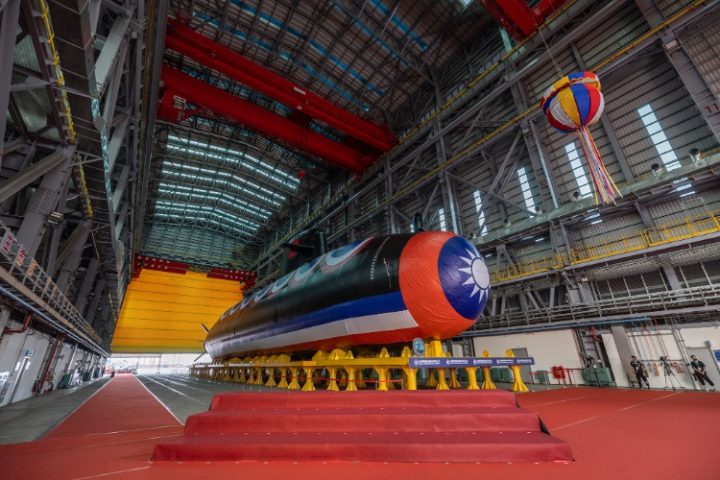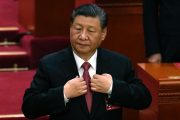
On September 28, Taiwan revealed its first domestically built submarine, as the self-governing island attempts to enhance its security against China.
Taiwanese President Tsai Ing-wen, vehemently opposed by Beijing for her denial of China’s authority over the island, started a submarine program in 2016 to deliver a fleet of eight vessels.
The first prototype, named Hai Kun, which means “mythical sea creature” in Mandarin, was launched on September 28 at a ceremony in the southern port city of Kaohsiung.
“History will forever remember this day,” declared Tsai, standing in front of the vessel draped in Taiwan’s flag colors.
“In the past, building submarines domestically was considered ‘Mission Impossible’. But today, a submarine designed and built by our own people is right in front of everyone — we did it,” she declared.
Cheng Wen-lon, chairman of submarine manufacturer CSBC Corp — which develops shipping containers and military vessels — admitted that the seven-year building process had the team working intensely, calling the submarine “a magical weapon in asymmetric warfare.”
Hai Kun measures 80 meters in length and has a displacement weight of about 2,500 tonnes to 3,000 tonnes. Moreover, it boasts combat systems and torpedoes obtained from U.S. defense company Lockheed Martin.
It will now be subjected to sea trials, with Tsai disclosing that Hai Kun would be operational by 2025 — though some defense analysts have said the time frame could be longer.
At the moment, Taiwan’s navy has two working submarines, namely Swordfish-class vessels purchased from the Netherlands in the 1980s.
In 2001, Washington authorized an offer to supply eight conventional submarines, but the sale did not take place.
During the same period, China built one of the world’s largest navies, with nuclear-powered submarines and aircraft carriers. China has about 60 submarines, six of which are nuclear-powered and armed with ballistic missiles, based on data from the U.S. Department of Defense, dwarfing Taiwan’s fledgling fleet.
However, Jiang Hsin-biao at Taiwan’s Institute for National Defense and Security Research acknowledged that mobilizing submarines at major choke points — such as the Bashi Channel and the Okinawa waterway — would be adequate to disrupt China’s military strategies against Taiwan.
“It can disrupt the People’s Liberation Army’s attempt to encircle and attack Taiwan from the east and west,” Jiang said.
“What surface ships fear most is attacks from underwater…. A submarine can make the enemy’s formation hard to defend and serve as a deterrence.”
Ben Lewis, a U.S.-based independent analyst on the Chinese military’s movements around Taiwan, said the submarine would jeopardize China’s amphibious assault and troop-transport capabilities.
“They have practiced extensively the use of civilian vessels to augment their existing troop delivery platforms, and a submarine could wreak havoc on vessels not designed for naval warfare.”
Nonetheless, Zivon Wang, a military analyst at Taipei-based think-tank Chinese Council of Advanced Policy Studies, said Taiwan still has a long way to go before it can be “combat capable.”
“The launch … does not mean that Taiwan will become very powerful right away but it is a crucial element of Taiwan’s defense strategy and a part of our efforts to build deterrence capabilities.”
On the same day of Taiwan’s domestic submarine launch, China’s Defense Ministry lambasted the island’s strategy of defending itself from an encirclement with its first locally built submarines as “idiotic nonsense.”
Ministry spokesman Wu Qian said, “No matter how many weapons the DPP (Democratic Progressive Party) authorities build or purchase, they cannot stop the general trend of national reunification.”
China, which claims Taiwan as territory to be reunified with the mainland, by force if necessary, has in recent years stepped up its military pugilism in the surrounding area as it reinforces its sovereignty claims to pressure Taipei.
Taiwan, which dismisses China’s sovereignty claims, has ramped up its defense expenditure, earmarking a historic U.S. $19 billion for 2024 — to obtain military equipment, especially from the United States.
Taiwanese Foreign Minister Joseph Wu said that China’s leadership knows that saber-rattling around Taiwan to manipulate its election outcomes would fail and Beijing would not likely attempt such actions before January’s presidential vote.
“The historical lesson is that the more China adopts a forceful way of intervening in our election, it’s going to backfire, and I think the Chinese leaders know that very well,” Wu told a news conference in Taipei.
“So it’s not likely for them to do anything major to threaten Taiwan or anything so visible that the Taiwanese people understand that they are trying to intervene in our election,” he added.
Vice President William Lai of the ruling Democratic Progressive Party is poised to be Taiwan’s next leader, based on opinion polls.
Additionally, Wu said China was preparing for a potential assault on Taiwan, including how China’s People’s Liberation Army would handle a possible American military intervention.
“So the scale has been increasing,” Wu said, adding that others in the region, including Japan, Australia, and the United States, have also been monitoring China’s movements.
China on September 28 also launched its first high-speed rail line that can travel across several bays and skim along the coast of the southeastern province of Fujian near the Taiwan Strait, state media reported.
A bullet train departed from Fuzhou, the capital of China’s Fujian province, marking the opening of the 277-km (172-mile) Fuzhou-Xiamen-Zhangzhou railway, Chinese state-run news outlet Xinhua reported.
This bullet train is China’s first cross-sea, rapid line with bullet trains that will travel over bridges across three coastal bays and hit top speeds of 350 kph (218 mph), state media added, quoting China State Railway Group Co Ltd, the country’s railway operator.
Travel time between Fuzhou and Xiamen, an economic hub and popular tourist destination, would be under an hour.
Notably, China Railway Siyuan Survey and Design Group Co Ltd designed the railway project. By 2022, China had 42,000 km of operational high-speed railway, and the length of high-speed rail regularly operating at 350 km per hour almost reached 3,200 km as of June 2022.
China recently revealed details of its plan to transform Fujian into a zone for integrated development with Taiwan, which is located just opposite the province. Also, China hopes the link would boost investment opportunities and facilitate travel.
A Chinese government official said an integrated multidimensional transportation network has been built in Fujian that “will make it technically possible to construct a high-speed transport passage linking the province with Taiwan,” state media reported.
Previously, China separately launched its first commercial suspended monorail line in Wuhan, the capital of Hubei province.
The monorail, spanning 10.5 km (6.5 miles), is fully automated and only requires human operation in an emergency, China Daily indicated.



